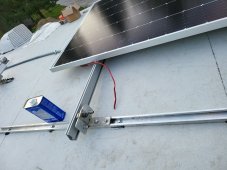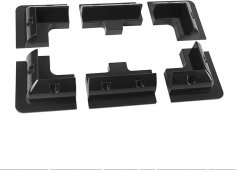inspectorrgadget
New Member
- Joined
- Mar 22, 2021
- Messages
- 15
I am building a roof-mount solar array consisting of six 100 watt panels, which will be secured to the roof by a pair of aluminum uni-strut rails.
This is the sort of strut I am using. It is 14 gauge, and can hold 90 pounds over its 10-foot length, unsupported:
Assuming a worst-case scenario of going 75 mph into a 15 mph headwind, the whole array could face a 90 mph wind load. (Don't worry, I usually drive 55 mph or less). How many lag bolts should be used to secure that uni-strut to the roof is my question.
My RV has aluminum rafters which support a rubber-covered plywood roof. The rubber roof is so old and crusty I can't get duct tape to adhere to it (forget about using VHB tape). So I am going to secure the uni-strut with lag screws into the metal rafters. I will use lots of caulk to protects against water intrusion. The fewer roof penetrations I have, the better. The more lag screws I use, the stronger the roof mount will tend to be. Determining the correct number of lag screws is something I can find no guidance for. Setting lag scew each 16 inches seems like overkill.
I used a studfinder (as well as an infra-red scope on a cool morning) to determine where the RV's rafters are. In general, the rafters tend to follow a pattern of about 16 inches apart (just like residential construction).
The pair of aluminum uni-strut rails have a total length of 15 feet. Actually, they are 10 feet long and 5 feet long, and will have to be lag-screwed down where the short and long struts meet together.
Herewith, I am diagraming the bare minimum of lag screws, as represented by e!clamation points:
0 ft----------10ft-----15ft
!-------------!--------!
Lag----------Lag----Lag
How many lag screws should be in between the Zero and 10 foot mark? How many lag screws between the 10 foot and the 15 foot mark?
If anyone has any guidance as to how many lag screws should secure a rail holding 6 solar panels over a length of 15 feet, please let me know.
This is the sort of strut I am using. It is 14 gauge, and can hold 90 pounds over its 10-foot length, unsupported:
Assuming a worst-case scenario of going 75 mph into a 15 mph headwind, the whole array could face a 90 mph wind load. (Don't worry, I usually drive 55 mph or less). How many lag bolts should be used to secure that uni-strut to the roof is my question.
My RV has aluminum rafters which support a rubber-covered plywood roof. The rubber roof is so old and crusty I can't get duct tape to adhere to it (forget about using VHB tape). So I am going to secure the uni-strut with lag screws into the metal rafters. I will use lots of caulk to protects against water intrusion. The fewer roof penetrations I have, the better. The more lag screws I use, the stronger the roof mount will tend to be. Determining the correct number of lag screws is something I can find no guidance for. Setting lag scew each 16 inches seems like overkill.
I used a studfinder (as well as an infra-red scope on a cool morning) to determine where the RV's rafters are. In general, the rafters tend to follow a pattern of about 16 inches apart (just like residential construction).
The pair of aluminum uni-strut rails have a total length of 15 feet. Actually, they are 10 feet long and 5 feet long, and will have to be lag-screwed down where the short and long struts meet together.
Herewith, I am diagraming the bare minimum of lag screws, as represented by e!clamation points:
0 ft----------10ft-----15ft
!-------------!--------!
Lag----------Lag----Lag
How many lag screws should be in between the Zero and 10 foot mark? How many lag screws between the 10 foot and the 15 foot mark?
If anyone has any guidance as to how many lag screws should secure a rail holding 6 solar panels over a length of 15 feet, please let me know.
Last edited:




